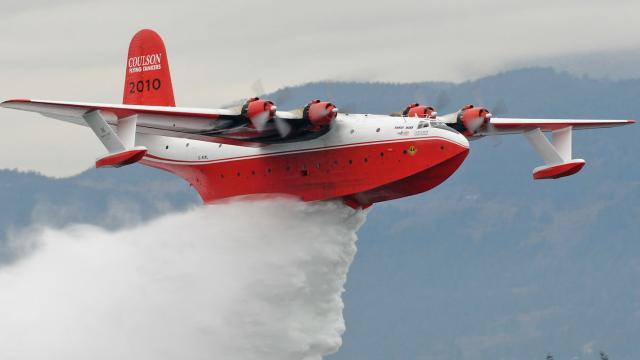General Douglas MacArthur once famously quipped, “Old soldiers never die; they just fade away.” Obsolete military equipment should be so lucky. While most outdated systems are simply scrapped, a lucky few find new purpose after their time in service — like the Martin JRM Mars, a coastal patrol bomber that now demolishes wildfires instead of invading armies.
At the outset of WWII, the US had yet to commit troops to the Allied effort but the American War Machine was already picking up steam. In 1938, the Navy commissioned the Glenn L. Martin Company to develop an oversized version of their existing PBM Mariner patrol bomber for use defending America’s lengthy coastlines.
The result, delivered to the US Navy in 1942, was the enormous XPB2M-1 Mars prototype. Nearly identical to the PBM Mariner in shape and construction, the Mars Prototype measured 36m long with a 60m wingspan and stood nearly 12m tall (that’s a two storey tall plane). Powered by a quartet of 2500 HP Wright 18-cylinder radial engines, the Mars offered an operational range in excess of 8000km at a cruising speed of 300km/h.
Unfortunately, over the five years it took to develop the Mars bomber, the US Navy’s defensive requirements evolved away from necessitating coastal patrol bombers, rendering the Mars prototype obsolete before it ever got off the ground. But rather than scrap the project entirely, the US Navy instead opted to convert the coastal bomber into a gigantic long-range transport aircraft.
The modifications were easy enough to make. As
Old Wings explains:
Testing was concluded in November 1942, but by that time the war situation in the Atlantic and the Pacific had changed considerably. There was no more need for a slow patrolbomber, and the U.S. Navy decided to have the Mars prototype converted from a patrol bomber to a transport aircraft. This meant the removal of its gun turrets, fuselage and wing bomb bays, armoured plating and other offensive provisions. Instead, the aircraft received additional cargo hatches and cargo loading equipment, existing hatches were enlarged and the decking was reinforced. It was now redesignated as an XPB2M-1R, to signify its new transport role.
Still called the Mars, the newly minted cargo plane carried a crew of four (with enough room to accommodate a secondary relief crew for long-haul flights) as well as up to 133 troops, seven jeeps, or 84 litter patients and 25 medical personnel — 14,500kg of stuff altogether. The US Navy initially ordered 20 of the humungous planes in 1943, but as the war progressed and the Allies goose-stepped Hitler’s forces right the fuck back to Berlin, need for these huge aircraft fell drastically. As such, the Navy reduced its order to just five units, essentially the aircraft already under construction.
Regardless of how many planes the Navy had, it certainly put them to good use. In 1949, the Caroline Mars set a world record by toting 269 people from San Diego to Alameda, CA. That doesn’t sound like much but realise this occurred in a plane bigger than a 737, carrying nearly 100 more people than a 737 can, and doing so nearly two full decades before the 737 ever got off Boeing’s drawing boards.

Despite the loss of the Marshall Mars in 1950 due to an engine fire (see above, no injuries to the crew), the remaining “Big Four” dutifully served the US Navy for another six years before being retired to NAS Alameda. There they sat for a number of years before being auctioned off in 1959.
Around this point in the mid-1950s, Western Canada was being decimated by raging wildfires. These fires proved incredibly difficult to fight given the region’s remoteness and challenging terrain. In response, a conglomeration of Canadian lumber companies including MacMillan Bloedel Ltd, TimberWest Forest Corp. and Pacific Forest Product Ltd, formed Forest Industries Flying Tankers (FIFT) — a privately-owned firefighting fleet. It was actually Dan McIvor, one of MacMillan’s most senior pilots, to strike upon the idea of converting these enormous transport craft into flying water bombers.
Unfortunately, McIvor was too late to get them direct from the Navy, Hugo Forrester of the Mars Metals Company has already snatched them up for a tidy total sum of $US24,000. Forrester, however, was willing to sell them to FIFT for $US25,000 a pop, which McIvor was able to swing with his superiors. And while he couldn’t get the planes themselves for cheap, McIvor did have the foresight to collect every single spare part he could get his hands on which is a big part of why the Big Four were able to operate well into the modern era.
The Hawaii Mars and Philippine Mars in fact is still in service in Western Canada, working for FIFT’s successor, Coulson. They have, of course been continually upgraded since the middle of last century in order to keep up with evolving aviation safety standards. The modern Hawaii Mars boasts an all-glass cockpit, digital avionics and environmental monitoring, and GPS positioning. [Martin Mars – Wiki – Old Wings]
Picture: Airliners.net
